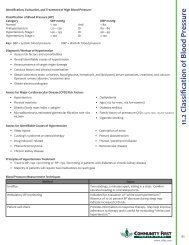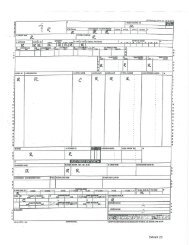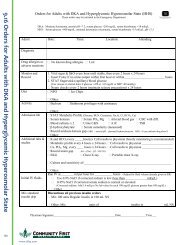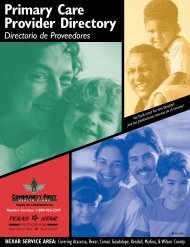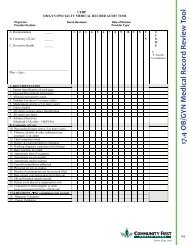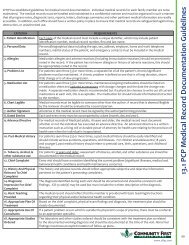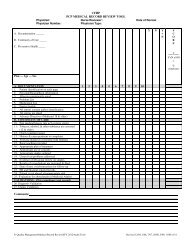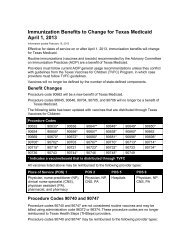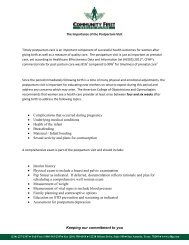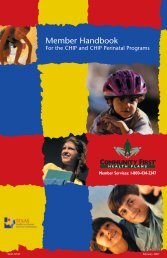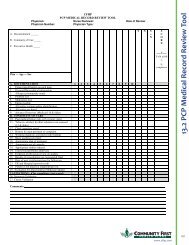Full Clinical Guidelines - Community First Health Plans.
Full Clinical Guidelines - Community First Health Plans.
Full Clinical Guidelines - Community First Health Plans.
Create successful ePaper yourself
Turn your PDF publications into a flip-book with our unique Google optimized e-Paper software.
CFHP has established guidelines for medical record documentation. Individual medical records for each family member are to be<br />
maintained. The medical records must be handled and maintained in a confidential manner and must be organized in such a manner<br />
that all progress notes, diagnostic tests, reports, letters, discharge summaries and other pertinent medical information are readily<br />
accessible. In addition, each office should have a written policy in place to ensure that medical records are safeguarded against loss,<br />
destruction, or unauthorized use.<br />
CRITERIA<br />
REQUIREMENTS<br />
1. Patient Identification Each page of the medical record must include a unique identifier, which may include patient<br />
identification number, medical record number, first and last name.<br />
2. Personal Data Personal/biographical data including the age, sex, address, employer, home and work telephone<br />
numbers, marital status of the patient, and emergency contacts must be included in the medical<br />
record.<br />
3. Allergies Medication allergies and adverse reactions (including immunization reactions) should be prominently<br />
noted in the record. If the patient has no known allergies or history of adverse reactions, this should<br />
be appropriately noted in the record.<br />
4. Problem List For patients seen three (3) or more times, a separate list of all the patient’s chronic/significant<br />
problems must be maintained. A chronic problem is defined as one that is of long duration, shows<br />
little change or is of slow progression.<br />
5. Medication List For patients seen three (3) or more times, maintenance/ongoing medications should be listed on<br />
a medication sheet and updated as necessary with dosage changes and the date the change was<br />
made. A separate medication sheet is recommended but if a physician chooses to write out all current<br />
medications at each visit, this is acceptable. The medication list should include information/instruction<br />
to the member.<br />
6. Chart Legible Medical records must be legible to someone other than the author. A record that is deemed illegible<br />
by the reviewer should be evaluated by a second person.<br />
7. Author Signature All entries in the medical record must be signed by the author/performing provider.<br />
8. Dated Entries Each and every entry must be accompanied by a date (month, day and year).<br />
9. Advance Directive For medical records of Medicaid adults, 18 years and older, the medical record must document<br />
whether or not the individual has executed an advance directive. An advanced directive is a written<br />
instruction such as a living will or durable power of attorney for health care relating to the provision of<br />
health care when the individual is incapacitated.<br />
10. Past Medical History For patients seen three (3) or more times, a past medical history should be easily identified and<br />
should include serious accidents, operations, and illnesses. For children and adolescents (18 years<br />
and younger), past medical history should relate to prenatal care, birth, operations, and childhood<br />
illnesses.<br />
11. Tobacco, alcohol, &<br />
other substance use<br />
For patients 12 years and older, assessment of tobacco, alcohol, and other substance use should be<br />
documented in the medical record.<br />
12. Chief Complaint Every visit should have a notation identifying the current problem (significant illnesses, medical and<br />
behavioral health conditions and health maintenance concerns).<br />
13. History And Physical<br />
Relevant To Chief<br />
Complaint<br />
14. Diagnosis/<br />
Impression For Chief<br />
Complaint<br />
15. Basic Teaching<br />
Provided<br />
16. Appropriate Plan Of<br />
Treatment<br />
17. Appropriate Use Of<br />
Consultants<br />
18. Appropriate Studies<br />
Ordered<br />
The history and physical records should reflect appropriate subjective and objective information<br />
pertinent to the patient’s presenting complaints.<br />
The diagnosis identified during each visit should be documented and should be consistent with<br />
findings. ICD-9 code(s) may be used but must include the written description of the diagnosis.<br />
The medical record should reflect that the member is provided with basic teaching/instructions<br />
regarding their physical and/or behavioral health condition.<br />
Based on the chief complaint, physical exam findings and diagnosis, the treatment plan should be<br />
clearly documented.<br />
If a patient problem occurs which is outside the physician’s scope of practice, there must be a referral<br />
to an appropriate specialist.<br />
The laboratory and other studies ordered should be consistent with the treatment plan as related<br />
to the documented working diagnosis and should be documented at the time of the visit. Abnormal<br />
findings must have an explicit notation of follow-up plans.<br />
13.1 PCP Medical Record Documentation <strong>Guidelines</strong><br />
H EALTH PLANS<br />
www.cfhp.com<br />
99



